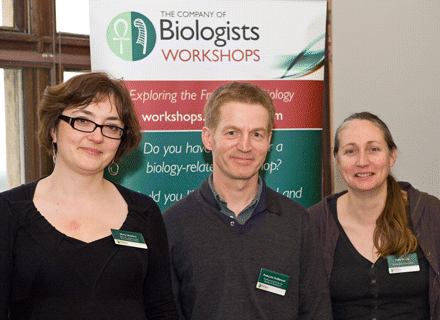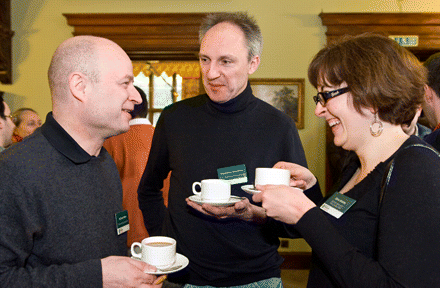An interview with Kate Storey and Silvia Marino
Posted by Eva Amsen, on 27 May 2010
(Originally published in Development)
In February 2010, in the beautiful setting of Wiston House, nestled at the foot of the hilly South Downs in Sussex, UK, The Company of Biologists, the not-for-profit organisation that publishes Development, held the inaugural meeting of their new workshop series dedicated to biological research. The meeting was titled ‘Neural Stem Cells in Development and Disease’, and was organised by Kate Storey, Professor of Neural Development at the College of Life Sciences of the University of Dundee, and Silvia Marino, Professor of Neuropathology at Barts and The London School of Medicine and Dentistry. They were also assisted by the workshop chairman, François Guillemot, Programme Leader of the Division of Molecular Neurobiology at the National Institute for Medical Research in London. The scientific scope and themes of this workshop are covered in more detail in a meeting review published in Development but, to get a glimpse behind the scenes, we talked to Kate Storey and Silvia Marino and asked them about the organisation of the ‘Neural Stem Cells in Development and Disease’ workshop.

Silvia Marino (left) and Kate Storey (right) with workshop chair François Guillemot.
Kate, you are on the Board of Directors of The Company of Biologists and co-chair its workshop committee. How did this workshop series come about?
KS: When I became a director of The Company of Biologists in 2007 I was asked to consider new ways in which the company might support the biological community. Two major workshop series had just ceased: the Juan March, based in Madrid, and the Ciba-Novartis Foundation symposium series in central London. I discussed this with fellow director James Briscoe as we walked across the fields overlooking the River Tay in Dundee and this is where the idea for The Company of Biologists Workshops was born.
How do the workshops tie in with the role of The Company of Biologists as a publisher of journals such as Development?
KS: The field of developmental biology is maturing and as it does it increasingly interfaces with other disciplines and utilises new technologies. The workshops aim to support this process: they set out be interdisciplinary and to break new ground.
Silvia and Kate, you both work with neural stem cells, but in different areas of the field. Can you briefly describe what you are working on?
SM: The aim of my group is to understand how biological properties of stem cells, such as self-renewal and differentiation, are controlled and how this knowledge can be applied to understand the molecular basis of diseases. We currently work with two model systems, adult neural stem cells and their relationship to brain cancer and satellite cells of the skeletal muscle and their role in muscle regeneration.
KS: Work in my group currently focuses on two aspects of vertebrate neural differentiation: the mechanisms downstream of key signals that direct neural differentiation onset in the extending vertebrate body axis, and the mechanisms regulating on-going neuron production in the spinal cord. The first involves linking signalling and epigenetic regulation of the differentiation of neural progenitors. To study the second aspect, we use real-time imaging of neuroepithelial cell behaviour. We want to know how signalling regulates changes in cell division mode, from progenitor-generating to neural stem cell mode divisions that produce a neuron and a progenitor.
How did you select the speakers for this workshop? Were there certain areas of research that you tried to cover?
KS: We were keen to bring together developmental biologists studying neural stem cells in a range of contexts, from flies to mice, in embryos and in adults, with clinical researchers investigating human neural tumours (gliomas, ependymomas, medulloblastomas, neuroblastomas) and other neural differentiation diseases.
SM: The speakers were selected on the basis of their research interest. Our aim was to create a good mix of basic scientists and more clinically oriented researchers.
KS: We also invited some young PIs and made sure to have a good gender balance. A further aim was that participants would know less than a third of the other contributors – this helped ensure we were cross-disciplinary.
Silvia, you were one of the workshop participants whose work is more directly related to disease. Your own research is in brain tumour formation, but what other neural stem cell-related diseases were represented at the workshop?
SM: We also had researchers present who are studying the role of neural stem cells in developmental abnormalities, such as cortical dysplasia and leukomalacia.
How important is it for clinicians or other researchers working specifically on the role of neural stem cells in human disease to stay in touch with more fundamental neural stem cell research?
SM: It is absolutely crucial. I strongly believe that a successful translational application of basic science discoveries is only possible in the context of a close interaction between basic and clinical scientists.
How important are developmental studies to the field of neural stem cells, and what talks at the workshop particularly illustrated this point?
KS: A good example of the importance of developmental studies is work on Drosophila neuroblasts, which has pioneered our understanding of the role of asymmetric cell division in assigning cell fate and cell behaviour. We heard talks from Chris Doe, Andrea Brand, Cayetano González and Jürgen Knoblich identifying and classifying the genes that determine whether a neuroblast remains a dividing stem cell or commences differentiation as a ganglion mother cell. Importantly, mutations of many of these genes generate tumours in the fly. A key emerging topic, raised by the genomic analysis of human neural tumours reported by clinician-researcher Richard Gilbertson, was the extent to which distinct fly tumours are analogous to different human brain tumours.
Has the workshop succeeded in bringing together various fields? Do you think it has seeded any collaborations?
SM: This was one of the main goals of the workshop.
KS: We have received emails from almost all the participants saying how productive the workshop has been for their research. We are aware of numerous new collaborations, including one researcher who established three new collaborations with people he had not met previously.
SM: Certainly, the workshop has brought together people that otherwise would not necessarily have met and the interaction among participants was very lively.
There were a few trainees present at this workshop as well. What made you decide to invite PhD students and postdocs, and how did you find and select them?
KS: Workshops are intimate events and if they are to work well it is important that there is a lot of discussion and informal time. We felt that postdocs and students would benefit from this too.
SM: The informal meeting format was ideal for them to interact with senior faculty members and for senior scientists to understand their perspective.
KS: At this first workshop we offered eight out of the 30 places to postdocs and students. These were advertised at the ISDB meeting in Edinburgh and on The Company of Biologists Journals’ eTOCs. After the deadline, applicants were selected on the basis of those most likely to benefit; we were looking for senior postdocs and students with some research experience or clinical PhD students.
This workshop was held at Wiston House – a 16th century mansion in West Sussex surrounded by parkland. How was this as a setting for scientific discussions?
SM: The setting was great. It created a comfortable and friendly atmosphere to stimulate interaction and informal discussion. Moreover, it was secluded enough to keep participants together for the duration of the entire meeting!
KS: The armchair-filled rooms were a real focus for discussion day and night.

An informal discussion between Silvia Marino and workshop participants Michael Weller (left) and Sebastian Brandner (centre).
What were your personal highlights of the workshop?
SM: The number of participants still chatting in the dining room at midnight, despite an internet connection being available in each room!
KS: As an organiser my personal highlight was just seeing it all begin to work in terms of interactions. The workshop was an experiment. We didn’t theme sessions, but juxtaposed clinical and basic research talks and mixed up developmental model organisms. It was meant to get us to think laterally.
Kate, now that this first workshop is over, has it given you some new ideas for the planning of future workshops run by The Company of Biologists?
KS: The excitement and productivity of the cross-disciplinary discussions at this first event makes me all the more convinced that this should be a strong characteristic of future Company of Biologists Workshops. We opened up the second series of workshops in 2011 to suggestions from the biological community and these are following this theme. More details can be found on The Company of Biologists Workshops website: http://workshops.biologists.com/.


 (No Ratings Yet)
(No Ratings Yet)